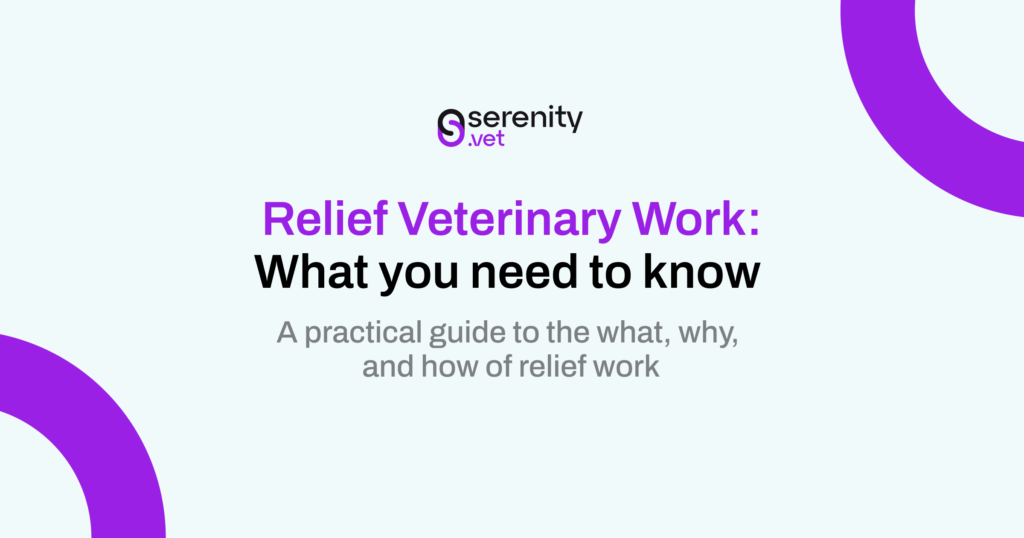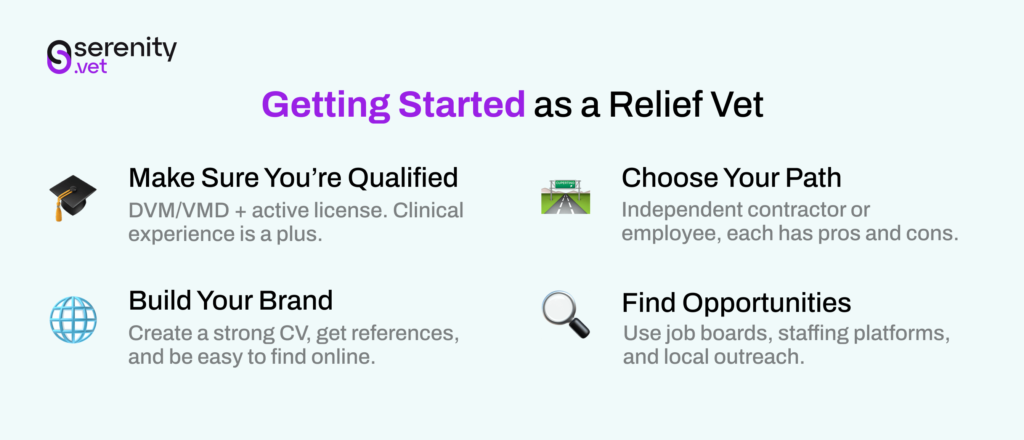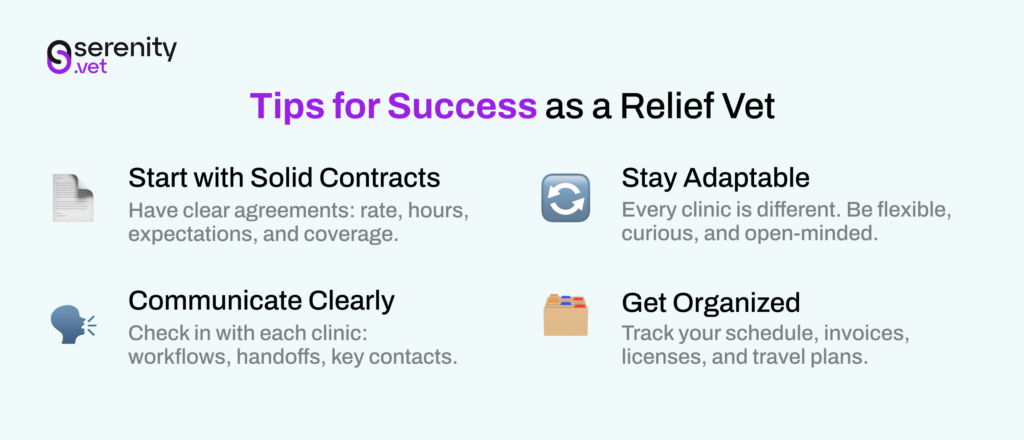
Relief Veterinary Work: What you need to know
If you’ve ever dreamed of a veterinary career that fits around your life, and not the other way around, relief work might be worth a closer look. It’s part of a growing shift in the profession, as more vets move away from traditional full-time roles in search of greater flexibility, variety, and a better work-life balance.
But what does relief work actually involve, and is it the right fit for you? In this article, we’ll break down what the job looks like day-to-day, the pros and cons to consider, how to get started, and tips to thrive. Whether you’re curious about making the leap or just exploring your options, here’s what you need to know:
I. What Is a Relief Veterinarian
A relief veterinarian is a licensed vet who steps in to provide short-term coverage at clinics that need extra support. That could be to cover for a vacation, help during a staffing shortage, or lend a hand during busy periods. Unlike full-time associates, relief vets work on a flexible, per-shift basis, often choosing when, where, and how often they practice.
You’ll find relief vets in all kinds of clinical settings – from general practice to ER to specialty hospitals, depending on their interests and experience. Some choose to stay close to home, while others take on opportunities across different cities, states, or provinces.
Most relief veterinarians work as independent contractors, which gives them more control over their schedule and workload. That also means they’re responsible for things like taxes, contracts, and business expenses, but many find the trade-off well worth the freedom.
In short: relief work is all about showing up where you’re needed, when you’re needed, while still having the flexibility to choose how you work, and with whom.
II. Getting Started as a Relief Vet
So you’re seriously considering relief work – now what? The good news: you don’t need a special certification or training to get started. But there are a few key steps to set yourself up for success, both clinically and professionally.
Here’s how to lay the groundwork:

✅ Make Sure You’re Qualified
At the very minimum, you’ll need:
- A DVM or VMD degree from an accredited program
- An active veterinary license in the state(s) or province(s) where you plan to work
- Clinical experience is a big plus: many clinics prefer relief vets who can jump in with minimal onboarding.
- Bonus points if you’re comfortable with different practice management systems or have experience in multiple types of practice (like GP and ER).
🧾 Choose Your Path: Contractor vs. Employee
One of the first big decisions you’ll face as a relief veterinarian is whether to work as an independent contractor or as an employee. The right path depends on your goals, your financial situation, and how much administrative responsibility you’re comfortable taking on.
In both the U.S. and Canada, most relief vets choose to operate as independent contractors. This route gives you more flexibility and control over your schedule, but it also means you’re essentially running a small business. That comes with extra responsibilities:
- Paying your own taxes (including self-employment taxes in the U.S., or setting aside income tax, CPP, and potentially HST/GST in Canada)
- Handling your own invoicing and payment tracking
- Sourcing your own liability and health insurance
- Setting up retirement savings plans (RRSP, TFSA, SEP IRA, etc.)
- Keeping organized records for tax season and business expenses
Many vets choose to work with a CPA or accountant familiar with relief work in their region – someone who can help you register properly, structure your finances, and plan ahead for tax time.
Alternatively, some relief positions (especially longer-term contracts or corporate relief roles) may offer employee (W-2 in the U.S., T4 in Canada) status. In that setup, the clinic handles taxes, may offer benefits, and provides more structure. However, you’ll likely have less control over your schedule or rates.
👉 Bottom line: There’s no one-size-fits-all answer. If you’re motivated by autonomy and don’t mind the business side of things, contractor life can be incredibly rewarding. But if you prefer simplicity and predictability, employee roles might be a better fit.
💼 Build Your Brand
Yes, even as a relief vet, having a “brand” matters. You’re essentially marketing yourself to clinics, so make it easy for them to say yes.
Start with:
- A clean, up-to-date resume or CV that highlights your strengths and experience
- References from past employers or colleagues who can speak to your skills and professionalism
- A simple but professional online presence, whether that’s a LinkedIn profile or a personal website
Being findable and easy to work with goes a long way in this field!
🔍 Find Relief Opportunities
There are a few ways relief veterinarians land gigs:
- Relief-specific job boards
- Veterinary staffing platforms (Like Serenity Vet 👋)
- Direct outreach to local clinics
- Word of mouth referrals and repeat clients are a huge part of building a steady relief schedule.
The key? Be proactive. The more visible and reliable you are, the more clinics will keep calling you back.
Relief work gives you freedom, but getting started takes some planning. The more you invest upfront in getting organized, the easier it becomes to build a steady, sustainable relief career.
Find Relief Shifts on Your Terms
Enjoy flexibility, better pay, and total control over your schedule with Serenity Vet.
III. Pros & Cons of Relief Veterinary Work
Like any career path, relief work comes with its own set of trade-offs. Whether you’re considering it as a long-term career move or a short-term transition, it’s important to understand both sides of the equation.
Here’s a look at what relief vets tend to love and what can be a bit more challenging.
✅ The Pros
Flexibility: This is one of the biggest draws of relief work. You choose when you work, how much you work, and where you work. Want to take time off in the middle of the week? Avoid weekends? Work intensively for a month, then take two weeks off? Totally your call. Relief work puts you in control of your schedule.
Variety: No two days look the same and that’s a huge plus for many vets. You’ll see different cases, work with different teams, and gain experience across a range of clinic settings. It’s a great way to build new skills, stay sharp, and keep things interesting.
Autonomy: Since you’re not a permanent member of the clinic, you’re often spared from the internal politics, long-term projects, or administrative duties that come with a full-time role. You show up, do great medicine, and head home.
Work-Life Balance: Relief work can offer a more sustainable pace, especially if you’re coming from a high-burnout environment. Many vets find it easier to prioritize personal time, travel, or family commitments when they have full control over their calendar.
⚠️ The Cons
Inconsistent Income: With flexibility comes variability. Some weeks may be packed, others may be slower (especially when you’re just starting out or during seasonal lulls). If you thrive on a steady paycheck, the unpredictability can be a challenge.
No Built-In Benefits: Most independent relief vets don’t receive benefits like health insurance, retirement contributions, or paid time off. That means you’ll need to budget carefully and plan for things like coverage gaps, sick days, and long-term savings.
Administrative Work: When you’re your own boss, the paperwork falls to you. That means handling contracts, invoicing, tax prep, and insurance, unless you’re using a platform or service to help manage the load. Staying organized is key.
Licensing Logistics: If you want to work across state or provincial lines, you’ll need to be licensed in each one. Keeping up with renewals, CE requirements, and paperwork can take some effort but it also opens the door to more opportunities.
Constantly Adapting: Relief work means jumping into new environments often—with different teams, workflows, software systems, and expectations. If you’re adaptable and quick on your feet, this can be energizing. But if you prefer familiarity and consistency, it may feel draining over time.
Relief work isn’t without its challenges, but for the right vet, it can offer a welcome sense of freedom and renewal. The key is knowing your priorities, being realistic about your lifestyle and goals, and having the right systems in place to stay organized and supported.
IV.Tips for Success as a Relief Veterinarian
Once you’ve laid the foundation, it’s all about building good habits that help you thrive: clinically, professionally, and personally. Relief work comes with a lot of freedom, but the most successful relief vets treat it like a business and a career.
Here are some tried-and-true tips to help you hit the ground running:

Start with Solid Contracts
Before you walk into any clinic, have a clear agreement in writing. A good contract protects both you and the clinic, and avoids awkward misunderstandings later. At a minimum, make sure it covers:
- Your rate and how/when you’ll be paid
- Your scheduled hours or shift expectations
- Any on-call duties or supervisory roles
- What happens if a shift is cancelled last minute
- Details about liability coverage (yours vs. the clinic’s).
If you’re unsure where to start, talking with a vet-specific legal or financial professional can be a game-changer. A good contract protects both sides and helps avoid misunderstandings down the line.
Communicate Clearly
Every clinic runs a little differently: different software, team dynamics, protocols, even exam room setups.
Take the time to check in with the team:
- How are cases typically handed off?
- Who’s your point person if something urgent comes up?
- What’s the preferred approach for callbacks or follow-ups?
Being proactive shows professionalism and makes you easier to work with – which is huge when you’re aiming for repeat gigs.
Stay Adaptable
Every clinic is a little different. From team dynamics to equipment setups, no two places run exactly the same. Approach each shift with an open mind, a sense of curiosity, and a willingness to go with the flow.
Flexibility is one of your greatest assets as a relief vet – lean into it!
Get Organized
Relief work can get chaotic if you don’t have systems in place. Stay on top of:
- Your schedule
- Invoices and payments
- Licensure and CE requirements
- Travel plans and clinic contacts
Whether it’s a planner, or a spreadsheet – find what works for you and stick to it. Organization doesn’t just save your sanity – it boosts your reputation, too
V. Is Relief Work Right For You?
Relief veterinary work isn’t a one-size-fits-all solution—but for the right person, it can be incredibly rewarding. If you’re thinking about making the leap, it’s worth asking: is this the kind of career that actually fits how I want to work and live?
Here’s what to consider.
🙌 Relief Work Might Be a Great Fit If…
- You’re independent and self-motivated: you like managing your own schedule and making decisions on your own terms.
- You’re adaptable and thrive in new environments: you enjoy learning different workflows, meeting new teams, and jumping into the unknown.
- You value freedom and variety over routine: you’re not looking for the same clinic, the same cases, day in and day out.
- You’re confident in your skills and judgment: you can walk into a clinic, assess what’s needed, and deliver great care without a lengthy onboarding process.
🤔 You Might Struggle With Relief Work If…
- You prefer structure, consistency, and routine: you like knowing what to expect every day, with long-term relationships and a predictable caseload.
- You find frequent transitions stressful: new clinics, new software, new teams can feel more exhausting than energizing.
- You’d rather focus on medicine and let someone else handle the logistics: paperwork, taxes, and scheduling don’t appeal to you.
- You value long-term client and patient relationships: you want to follow cases over time and be a familiar face in the exam room.
🧠 Questions to Ask Yourself
- Do I enjoy variety or do I find comfort in consistency?
- Am I comfortable working in unfamiliar environments with minimal onboarding?
- Can I stay organized and handle the business side of being an independent contractor?
- What do I want out of my veterinary career right now? Is relief work a stepping stone or a long-term plan?
VI. Final Thoughts
Relief veterinary work isn’t just a way to fill shifts. It’s a flexible, dynamic career path that puts you in control. Whether you’re looking to escape burnout, explore new clinics, travel more, or simply take ownership of your schedule, relief work can offer the freedom and balance that full-time roles sometimes can’t.
But that freedom comes with responsibility. From managing your own time and finances to staying licensed and organized, success as a relief vet requires planning, adaptability, and a clear sense of what you want out of your career.
If you’re up for the challenge, the rewards can be huge – more variety, more autonomy, and more room to build a life and career that work together.
And you don’t have to do it alone.
At Serenity Vet, we’re here to support you. From finding the right shifts to helping with rate negotiations, we make relief work easier, smoother, and more sustainable.
Take control of your veterinary career. Sign up with Serenity Vet and start working on your terms.

